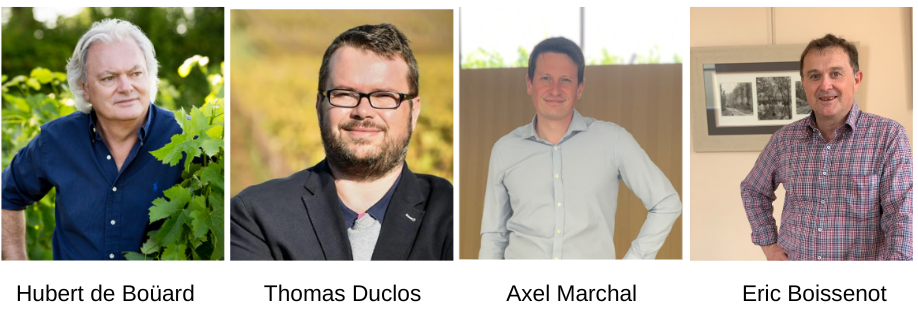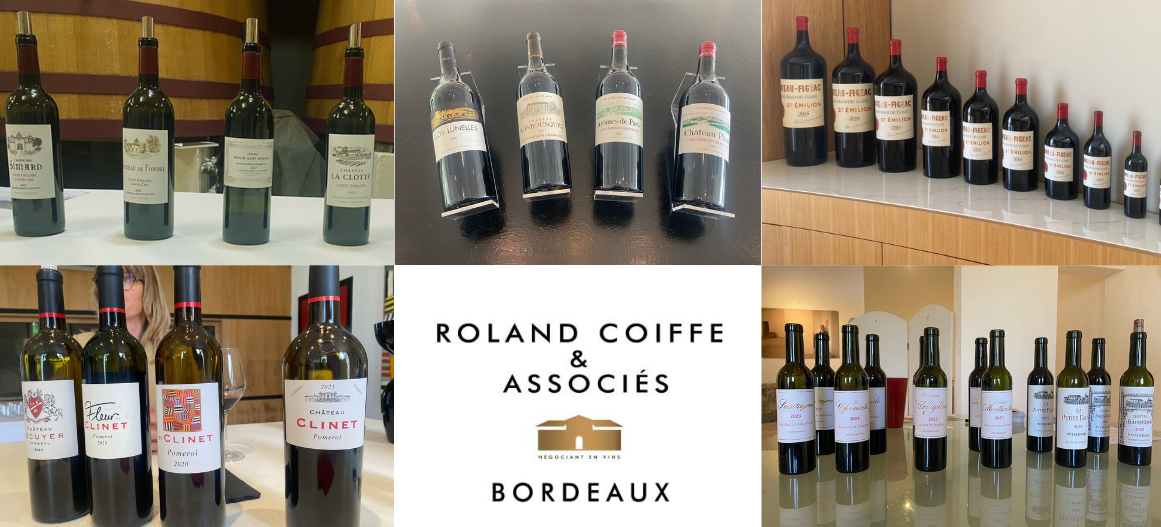Vintage 2023: When Bordeaux reinvents its classics
Gerda: The Primeurs 2023 tasting week came to an end last week. It was an intense and important week for La Place, during which more than 5,000 wine professionals of 70 different nationalities discovered the new vintage. Detailed reports on 2023 and notes from some of the wine critics have already been published. Before giving the floor to the experts, we begin with a summary of the 2023 vintage by the RCA team. Following that, we’ll dig into the answers provided by four esteemed consultants — Axel Marchal, Eric Boissenot, Thomas Duclos, and Hubert de Boüard — to encapsulate the essence of this new vintage. Everyone has been in the starting-blocks since Monday 29 April for a start in a complicated macro-economic and geopolitical context. “Nevertheless: let’s remain optimistic, because there’s no future in pessimism!”
The opening night at Château Cantenac Brown was a truly remarkable display of elegance and refinement. This new building is truly impressive, representing a significant advancement in technical choices through its eco-friendly architectural innovation. Cantenac Brown is taking up the zero-carbon challenge by doing without cement altogether, giving preference exclusively to bio-sourced materials sourced from less than 100 km away. This includes the creation of a clay winery, an ancestral construction technique using raw earth.
The celebration of La Commanderie du Bontemps marks the end of the primeurs week with a sumptuous dinner where châteaux, negociants, and courtier gather with their clients and partners. 
Summary of the 2023 vintage by the RCA team
The 2023 Bordeaux vintage, characterized by a return to more traditional climate conditions and meticulous vineyard management, promises excellent quality, with potential price adjustments in response to global economic pressures making it an attractive option for buyers. A brief overview of this vintage:
- Climatology of the vintage
- Harvest and Winemaking
- Tasting the wines
- General Economic Context
- Prices
Climatology of the vintage
After the extreme heat and drought of 2022, 2023 marks a return to a more typical climate for Bordeaux with warm temperatures and average rainfall, promoting superior harvest quality. Vigilance against diseases like mildew was essential, requiring meticulous attention throughout the season to maintain vine health.
Harvest and Winemaking
Reds: The red wine harvest occurred quite early and spread over a long period with yields higher than average and excellent juice quality, aided by increasingly professional vineyard management.
Dry Whites: The dry whites benefited from the cool nighttime temperatures, preserving their acidity and aromatic freshness.
Sweet Wines: The favorable conditions for botrytization led to the production of rich and complex wines, with alternating wet and dry periods contributing to their depth of flavor.
En Primeur Wine Tasting
Overall, the wines show a beautiful tannic structure, marked aromatic intensity, and good aging potential.
Left Bank Reds: The wines are elegant, with well-structured tannins, precise, featuring average alcohol levels (13-13.5%) and freshness.
Right Bank Reds: In Pomerol and Saint-Emilion, the wines express appreciable fruit richness, with notable concentration.
Dry Whites: The wines are lively and expressive, with refreshing acidity, marking a great vintage for dry whites.
Sauternes: Exceptional aromatic richness, great complexity, and impressive length on the palate

General Economic Context
Globally, the wine market is facing economic pressures, influencing estate strategies.
United States: The American market remains robust, although cautious due to stock levels and the election year.
Europe: Stability with reduced demand, with operators’ caution being predominant.
Asia: Faced with a demand drop due to the real estate crisis in China, unfavorable exchange rates, and stock accumulation in recent years.
Prices
For the 2023 Bordeaux vintage, prices are likely to be adjusted downward despite the high quality of the wines, in response to global economic pressures and the caution of key markets. Major chateaux are already announcing reductions, indicating a trend towards more accessible prices to stimulate demand. This strategy could make the 2023 vintage particularly attractive to buyers.
Gerda’s Interview
Expert insight 2023: the ultimate reflection of different terroirs
Four personalities share their views on the vintage:
- Hubert de Boüard, Director of HdB Consulting and Œno-lab, co-owner of Angélus
- Thomas Duclos, Consultant Oenologist
- Axel Marchal, Professor at the University of Bordeaux and Consultant Oenologist
- Eric Boissenot, Consultant Oenologist

Gerda: What was the biggest challenge for the winemakers in 2023?
Hubert de Boüard: Reaching maturity with perfectly healthy grapes.
Thomas Duclos: Staying composed and not over-reacting to mildew was crucial. It was important not to compensate for the lack of heat at the beginning of August by thinning out the leaves too much or dropping too many grapes. Patience was the key, as the harvest took a long time so that all the grapes could ripen… In short, patience, analysis and foresight were required.
Axel Marchal: It was adapting, because conditions were very changeable and throughout the cycle there were a number of difficult climatic conditions. We had to adapt. Despite everything, the biggest challenge was downy mildew which, once again, due to the damp spring and early summer, occasionally accompanied by hot periods, posing a significant threat to the vineyard.
Eric Boissenot: It was the fight against cryptogamic diseases, and the pressure was very high, as in 2016 and 2018.
Gerda: Could you say a few words about the 2023 yields?
Hubert de Boüard: Yields are good, firstly thanks to years of respect for our soils and their microbial life, but also thanks to constant prophylaxis, which has meant that we have not been affected by disease. Château Angélus yields is around 40 hl/ha this year.
Thomas Duclos: It’s very uncertain because of the variations in rainfall… which have led to very variable berry size. Yields are still an issue, but for me they’re much less important than they were 15 or 20 years ago. Furthermore, with global warming, it’s becoming easier to achieve grape ripening.
Axel Marchal: Yields illustrate the highly variable nature of the vintage. In some cases, yields are very low, often on estates where Merlot predominates. Sometimes, yields are between 20 and 25 hl/ha. On the other hand, some estates that were little affected by mildew were able to achieve more than satisfactory yields of around 50 hl/ha. Not all properties were affected by mildew. Harvest potential was high this year, as conditions for flower initiation in 2022 were very good, and those for 2023 are also very favourable. All of this has contributed to a fine potential due to the number of berries per bunch and the size of the berries, which were favoured by a slightly rainy climate at the time of fruit set, i.e. when the grape berry forms.
Eric Boissenot: The number of inflorescences was high and flowering went very well, with no coulure, except in the case of mildew on certain plots, often Merlot (more sensitive). Yields in 2023 are generally higher than in the last five years.
Gerda: Could you describe the style of the 2023 vintages?
Hubert de Boüard: 2023 is a vintage full of very subtle floral aromas, such as violets and cloves, but also expresses black fruits such as cherries and wild blackberries. It’s a serious, juicy wine, with lovely rounded tannins and good acidity, bringing a saline, taut edge to the tasting.
Thomas Duclos: It’s impossible, there are so many variations in this vintage… We can sum it up by saying that 2023 is one of those vintages that only Bordeaux can produce, with some of the best wines, characterised by great precision.
Axel Marchal: It’s a varied vintage offering a range of distinct wines. On the whole, these are wines with a lower level of alcohol than the last great Bordeaux vintages. This is particularly evident in the Cabernets. Despite this, there is a fairly high level of acidity, which adds freshness to the wines, which also have very pronounced tannic structures. The wines are well-balanced, fresh and fairly classic in form, less exuberant than those of 2022, which I really like for its unusual character. It’s a great vintage, but with a slightly opulent character.
I think 2023 is more within the norm, but a high norm! These are very Bordeaux wines, pleasant and amiable. Sometimes the wines lack the concentration and density to rival the greatest vintages. They are both wines that can be enjoyed soon after bottling and excellent candidates for aging.
Eric Boissenot: These are full-bodied wines with rich, supple tannins that are both ripe and fresh, with good acidity that is less sun-drenched than the 2022 vintage and lower alcohol. They are closer to the style of 2019 but are straighter. They also have hints of the 2020 vintage in their behaviour.

Gerda: As a technician, do you think that a price revaluation is essential to save the Primeurs 2023 campaign?
Hubert de Boüard: I think that, above all, you have to know your market and your consumers, and respect them. That way, everyone will understand the message.
Thomas Duclos: As a technician, I have an opinion that I keep to myself, as everyone should do when it’s not their own area of expertise.
Axel Marchal: During the pandemic, the French philosopher Étienne Klein revived the term ‘ultracrepidarianism’, which refers to the art of talking about what you don’t know. Although my field of expertise is not the wine trade, my feeling, which is not that of a specialist, is that a price cut is necessary and inevitable. I’m talking here about the Crus Classés and I’m talking about wines for which the selling price is well above the cost price. There are a number of wines in Bordeaux for which selling prices are below cost price levels. It’s not a solution for these wines to lower prices because the estates simply can’t afford to do so.
Eric Boissenot: Yes, that’s still true, even if the quality of the wines is very high.
Gerda: If you had to describe 2023 in one short word or phrase, what would you choose?
Hubert de Boüard: A delicious and refreshing moment, without doubt the most ‘Bordeaux’ of all Bordeaux wines!
Thomas Duclos: Ambition has paid off!
Axel Marchal: A diverse vintage, for different reasons: there’s heterogeneity in terms of yields and qualities, and one very marked characteristic sets this vintage apart. The impact of the terroirs is clearly perceptible. Merlot grown on limestone does not have the same flavours as Merlot grown on gravel, which in turn differs greatly from Merlot grown on sand or clay. This is a vintage that very accurately reflects the specific characteristics of the terroirs.
Eric Boissenot: It’s a friendly, indulgent vintage, much like a reliable friend whose company is always appreciated. We can count on him.
The Roland Coiffe & Associés team wishes you a very successful En-Primeurs campaign



